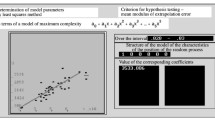The so-called “unexpected” results of statistical processing of data from increasingly more accurate astrophysical and gravitational measurements are examined. The reasons for the breakdown of the logic of statistical inference, which several leading experts have interpreted as a “metrological and scientific impasse” in cosmology, are pointed out. The data on type SN Ia supernovae used to detect the “accelerating expansion of the universe” are analyzed. It is shown that the errors in the Friedman–Robertson–Walker model as an equation for indirect measurement of distance are multiplicative. Here the hypothesis of a Gaussian form for these errors corresponds to a shift of –2.8% and a mean square deviation of 16.3% for a mean square deviation of the arithmetic mean of 1.8%. It is noted that using the mean square deviation of the arithmetic mean as an indicator of the accuracy of the scale is a crude mistake.
Similar content being viewed by others
References
T. Quinn, H. Parks, C. Speake, and R. Davis, Phys. Rev. Lett., 111, L 101102 (2013).
G. Rosi, F. Sorrentino, L. Cacciapuoti, et al., Nature, 510, 518–521 (2014).
“Measuring the gravitational constant as a cause for debate!” https://ru.wiki pedia.org/w/index.php?title=Gravitatsionnayapostoyannaya&oldid=10035653.
S. F. Levin, Proc. Intern. Sci. Meeting PIRT-2003, Moscow, June 30–July 3, 2003, Coda, Moscow, Liverpool, Sunderland (2003), pp. 72–81.
G. Feldman and R. Cousins., Phys. Rev. D, 57, No. (7), 3873–3889 (1998).
S. F. Levin, “Anisotropy of the red shift,” Giperkompl. Chisla Geom. Fiz., 8, No. 1 (15), 70–101 (2011).
S. F. Levin, Phys. At. Nucl., 78, No. 13, 1528–1533 (2015).
D. Branch and G. A. Tammann, Ann. Rev. Astron. Astrophys., 30, 359–389 (1992).
A. G. Riess et al., Astron. J., 116, 1009–1038 (1998).
S. Perlmutter et al., Astrophys. J., 517, 565–586 (1999).
J. L. Tonry et al., Astrophys. J., 594, 1 (2003).
M. Visser, “Jerk, snap, and the cosmological equation of state,” http://ArXiv:gr-qc/0309109 v4 31 Mar 2004, acc. Jan. 12, 2019.
A. G. Riess et al., ArXiv: 1604.01424v3 [astro-ph.CO] 9 Jun 2016.
R. L. Beaton, W. L. Freedman, B. F. Madore, et al., ArXiv: 1604.01788v3 [astro-ph.CO] 11 Nov 2016.
W. Freedman et al., ArXiv: astro-ph/0012376v1 18 Dec 2000.
W. L. Freedman, Arxiv.org: 1706.02739 13 Jul 2017.
A. Riess et al., accepted by Astrophys. J., March 26, 2019, ArXiv: 1903.07603v2 [astro-ph.CO] 27 Mar 2019.
A. R. Sandage, Problems in Extragalactic Research, G. McVittie (ed.), Macmillan, New York (1962).
C. Lang, Astrophysical Formulae [Russian translation], Mir, Moscow (1978).
H. C. Arp, APEIRON, No. 9–10, 53–80 (1991).
H. C. Arp, Month. Not. Royal Astron. Soc., 258, 800–810 (1992).
I. D. Karachentsev and D. I. Makaro, Proc. IAU Symp., 186, 109 (1999).
D. J. Schwarz and B. Weinhorst, Astron. Astrophys., 474, 717–729 (2007).
S. F. Levin, Proc. XV Int. Sci. Meeting PIRT-2009, Moscow, July 6–9, 2009, BMSTU, Moscow (2009), pp. 234–240.
Rong-Gen Cai and Zhong-Liang Tuo. ArXiv: 1109.0941v5 [astro-ph.CO] 11 Jan 2012.
J. Sollerman et al., ArXiv: 0908.4276 v2 [astro-ph.CO] 1 IX 2009.
G. Hinshaw et al., Preprint WMAP, Draft Version, Dec 19, 2012.
S. Turyshev, ArXiv:1107.2886v1[gr-qc] 14 Jul 2011.
J. Dunkley et al., Astrophys. J. Suppl., 180, 306–309 (2009).
D. Larson et al., Preprint WMAP, 26.01.2010, http://lambda.gsfc.nasa.gov/product/map/dr4/pub_papers/sevenyear/powspecra/wmap_7yr_power_spectra.pdf.
Planck Collaboration, Astron. Astrophys., 594, A13 (2016).
S. F. Levin, “Photometric cosmological distance scale. Part 1. “Unexpected” results,” Izmer. Tekhn., No. 2, 3–8 (2014).
B. P. Schmidt, “Accelerated expansion of the universe from observations of distant supernovae,” Usp. Fiz. Nauk, 183, No. 10, 1078–1089 (2013).
S. F. Levin, “Cosmological distance scale. Part 8. Scale factor,” Izmer. Tekhn., No. 1, 8–15 (2019), DOI: 10.32446/ 0368-1025it.2019-1-8-15.
M. V. Pruzhinskaya, Supernova Stars, Gamma-Bursts, and the Accelerated Expansion of the Universe: Cand. Dissert. in Phys.-Math. Sciences, Lomonosov MSU (2014).
S. F. Levin, “Cosmological distance scale. Part 6. Statistical anisotropy of red shift,” Izmer. Tekhn., No. 5, 3–6 (2017).
S. F. Levin, Optimal Interpolation Filtering of Statistical Characteristics of Random Functions in a Deterministic Version of the Monte Carlo Method and the Red Shift Law, NSK AN SSSR, Moscow (1980).
F. Hoyle, in: Gravity, Neutrino and the Universe, J. Wheeler (ed.) [Russian translation], Inostrannaya Literatura, Moscow (1962), pp. 372–400.
O. Heckmann, Theorien der Kosmologie, Springer-Verlag, Berlin, Heidelberg (1942).
Author information
Authors and Affiliations
Corresponding author
Additional information
Translated from Izmeritel’naya Tekhnika, No. 10, pp. 8–14, October, 2019.
Rights and permissions
About this article
Cite this article
Levin, S.F. Cosmological Distance Scale. Part 9. Deceleration Parameter. Meas Tech 62, 855–862 (2020). https://doi.org/10.1007/s11018-020-01705-3
Received:
Accepted:
Published:
Issue Date:
DOI: https://doi.org/10.1007/s11018-020-01705-3




